Long before the Internet, the ABDL community grew from a few scattered personal ads to ABDL-specific organizations with their own periodicals. While there have been a number of notable ABDL leaders in the community's past, non-ABDLs also played a substantial role. In general, the stage was set by the organization and activism of GLBTs. More specifically, a rubber fetishist writer, a seamstress grandmother, and a transsexual publisher would play key roles alongside ABDLs in the birth of the ABDL community.
It is unclear when ABDL material started to appear in print. For example, "London Life" is sometimes discussed as carrying the letters of ABDLs before their offices were destroyed during World War II. One pre-Stonewall publication was Canada's "Justice Weekly", which in 1965 included texts such as "Diapered Hubby of 48 Also Writes", written by "Diapered, Dominated Husband"[1]. These might have been sufficiently free of mainstream sexual elements to avoid censorship.
In the 60's and 70's, adult, gay, and underground publications were being established and becoming more liberated. They were carrying more content, including more ads and letters. Dr. Speaker's masters thesis documented one ABDL, Kent Perry, who built a network of several hundred, starting with personal ads in the "LA Free Press" in 1970 or 1971[2]. He also placed ads in "Fetish Times", "The Advocate", and "Rubber Life". It was estimated that 75% of gay infantilists first discovered they were not alone when they found an ad, such as in the nation's largest gay newspaper, "The Advocate." [3]. Letters and ads also appeared in "Penthouse Letters", "Forums", and "Variations" as well as other adult magazines.
In the mid 70's, the pornography industry tested the water with a few publications that included diapers with a mix of other themes and more mainstream sexuality. Much emphasis was given to more established alternative markets, such as rubber fetishism and transvestism. In terms of marketing, this made sense: Limited shelf space in adult bookstores meant that publications needed to appeal to wide segments.
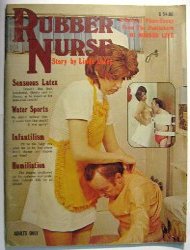
One 1974 example is "Rubber Nurse." It was published by the House of Milan (in Los Angeles, California) as a spinoff from "Rubber Life." Unsurprisingly it included a lot of rubber. It details a scene between a submissive and his dominatrix, involving repeated diapering, spanking, enemas, strained prunes, a collar, a leash, bottle feeding, breast feeding, whipping, handcuffs, public exposure, a pivoting table with straps, etc. A notable element is the nurse's awkward manhandling of the "baby", including tossing him. This didn't work very well, but suggests that new ground was being broken. Later sources would have been able to learn from this mistake.
The "Rubber Nurse" was written by "Linda Latex." Later ABDL-specific periodicals would include her columns and stories. The recurring title was "The Wet Set ... Case Histories by Linda Latex," which was a column "The Play Pen," a booklet, and possibly others. It is unclear whether this and other content that Linda Latex distributed was intended to be a catalyst for the developing ABDL community, or whether it just worked out that way. (Two decades later she would contribute the case history of Michael L. to Understanding.Infantilism.Org.)
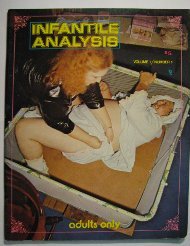
Another early example is "Infantile Analysis", published in 1976 by London Enterprises in Van Nuys, California. There was, to the disappointment of few, no analysis in it. In contrast to "Rubber Nurse," this publication included an emphasis on transvestism. It included a third character (a crossdressed maid) and lots of frilly, custom clothing. It also included an item of adult-baby-specific furniture: There was a playpen that had been crudely reinforced for the weight.
In addition to being from publisher located in the Los Angeles/Inland Empire area of California, but named after other cities, these publications had a few other common features. They had text describing a plausible scene, illustrated with mostly black-and-white pictures that followed the text, at least roughly. This isn't always the case: It isn't rare for publications to intermix pictures of women in diapers with text of men in diapers, for example.
In addition, both also used the word "infantilism." At the time, the term "infantilism" was transitioning from a misuse of "psychosexual infantilism," popularized by Wilhelm Stekel's 1952 book, to "paraphilic infantilism," as defined by the American Psychiatric Association in 1987.
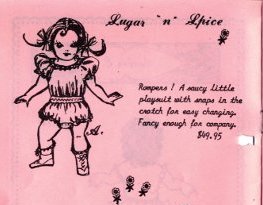
Starting with "The Play Pen" around 1975, we meet two other pioneers of the ABDL community, who weren't necessarily ABDLs. The first is Florence, a grandmother who had a small business making clothing for male transvestites, called "Amber Enterprises." She operated in Milpitas, California, over 300 miles from the Los Angeles/Inland Empire area, but not far from San Francisco and Oakland. According to a 1978 San Jose Mercury article about her, she was putting together a catalog of custom clothing and "a friend suggested a page of adult-sized baby clothes." Before this, Florence hadn't known about the interest. This would have been around 1973. (To the right, there is a sample of a later catalog, dedicated to adult baby clothing.) She then started exchanging letters with customers. "In a short time I realized that I could reach and comfort a lot more babies by putting together their stories and letters, enabling them to really know that they were not alone."
It is unclear if she learned about the phrase "adult baby" through these letters or coined it herself. Clearly, she did help establish it: The cover of "The Play Pen" #1 describes it as "the magazine for the adult baby."
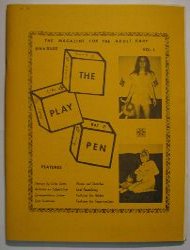
The first two issues were full magazines, with 68 pages of contributed letters, stories, pictures, and drawings. They were black and white, folded and stapled. However, they weren't edge-trimmed like those from House of Milan or London Enterprises. They were typed in Florence's characteristic, cursive font.
Personal ads were included, but usually did not include addresses or phone numbers. A code, such as "B147", was provided for contact. Readers were instructed to send a first correspondence in two envelopes. The inner envelope would have a stamp and the sender's return address, as well as the code written in pencil. This would go inside the outer envelope with $1, and be sent to Amber Enterprises. There, the code number on the inner envelope would be replaced with the address, and forwarded. Similar mailing lists would be maintained by "Lil'Wrangler."
The distribution of issue #1, at the time of #2, was only 113 copies. Florence claimed a net loss of $1000. Later issues would offer commercial ads, but only include a few. Those few were for various goods and services, including hypnosis tapes.
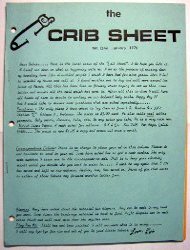
"The Crib Sheet" may have been started by Florence as a stopgap measure while dealing with publishers. This newsletter consisted of a couple double-sided 8 1/2" by 11" pages, simply stapled together. The first issue of "The Crib Sheet", dated January 1976, mentions that "The Play Pen" #3 still has not been printed. This suggests that "The Play Pen" #1 would have been published in 1975 or before. "The Crib Sheet" was published monthly from Jan 1976 to May 1976, and then from February 1979 until at least May 1980. The binding method changed over time, suggesting that Florence's troubles with publishers continued.
February 1979 was described as a "re-opening" of Amber Enterprises, with Florence producing "The Crib Sheet" and Cathy Slavik taking over "The Play Pen." Florence went by "Lori" for the first few issues of "The Crib Sheet", but then changed back. "I just thought it looked pretty in the script letters" Florence wrote. Amber Enterprises was contracted to "Amber E." because it "sounds nicer that way."
The August 1979 issue was photocopied with support from the "Back Drop Club." As described in the last two pages of the next issue, the "Back Drop Club " was a rapidly growing local BDSM organization that offered, among other things, locksmithing services and adult baby clothing. It could be speculated that she met Tommy, founder of DPF, through this contact.
Florence sold Amber E. to Tommy of DPF for an initial payment plus royalties. Tommy of DPF considered Florence to be "probably the earliest pioneer in the world of Infantilism." Florence passed away in 1997.
In the first issue of "The Play Pen," Florence thanks Cathy Slavik of the Empathy Club for encouragement. Cathy was a transsexual author near Seattle, Washington. Like Florence, Cathy also had trouble finding a publisher who was willing to handle adult material. Starting with #4, "The Play Pen" would be an edge-trimmed magazine, produced by Cathy and published by "Infantae Press" in Seattle. (#3 was a 5 1/2" by 8 1/2" booklet published in Seattle, but not edge-trimmed.)
"The Play Pen" then included a wider range of content and sources, as well as type fonts. For example, issue #8 (1982) included the case studies from soon-to-be-Dr. Speaker's masters thesis, with a note that the complete thesis was available from Lil' Wrangler Enterprises, Inc., in Oakland, California. Issue #9 includes an article titled "Baby Critique," on willing vs. unwilling adult babies. A concept that ABDLs are still trying to learn to communicate more fluently. (Ten years later, this would be independently sketched out on 'the ABDL triangle') It also included a timely study of the new disposable adult diaper industry.
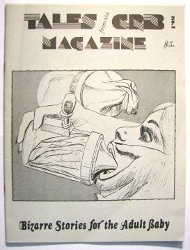
Intermixed with the clearly authentic reader-provided material, there was a growing amount of commercial material. This is most clear from the pictures: The reader-provided pictures were small and sometimes poorly exposed, and were generally of men. The other pictures were professional - even down to the black tape over the eyes of some models - and showed only women.
Issue #9 included some pictures of Japanese-style diapers and plastic pants. A series of photos of a Japanese (or at least Asian) diaper model with them were in "The Play Pen" #10. Instructions on how to fold them would be printed in "True Baby Letters and Experiences" #2 in 1985, also published by Infantae Press. #10 might have been the last issue, of "The Play Pen", in 1986.
In 1979, Cathy Slavik began producing "Tales from the Crib ... Bizarre Stories for the Adult Baby." These black and white magazines included a few stories with line drawings. Some included reader letters or articles presented as if clipped from a ten-year-old newspaper. The authors included "David Wetmore" and "Daphne, DDD (Doctor of Diaper Discipline)." The stories were mixed, but tended to have female submissives dominated by men or women, usually with some form of bondage. #15 (1987) might have been the last issue of "Tales from the Crib." Like "The Play Pen" #10, it had a glossy cover.
Parallel to these events was an increase in the visibility of adult diapers, especially in the US. ABDLs were now able to order well-made, mass-produced diapers and plastic or rubber pants. The 1979 "Spring and Summer" Sears catalog included disposable diapers in adult sizes. By 1984, there would be ten kinds of adult disposable on the market. Most of these were wingfoldsDEF made on converted underpad machines. However, Proctor and Gamble invested heavily in promoting their new product, Attends®. This made the use of adult diapers more visible and to some extent, more accepted. Sears and Attends® might not have caused any new cases of infantilism or diaper fetishism, but they permitted ABDLs in the average household to know that other adults were wearing diapers. This brought them one step closer to exploring the possibility that other adults enjoyed diapers, which then might have brought them into contact with the growing ABDL community.
These ads, newsletters, and magazines established the ABDL community. While the key steps were taken by ABDLs, much of the groundwork was laid by non-ABDLs. Three who played key roles in this development were Linda Latex, Florence, and Cathy Slavik; a rubber fetishist author, a seamstress grandmother, and a transsexual publisher. The community would undergo two more stages before becoming what it is now. The first is associated with Tommy of DPF; and the second with Compuserve, AOL, and IRC.
After the 70's, ABDLs were much more visible. When Infantae Press published "True Baby Letters and Experiences" issue #2 in 1985, the "Ask Baby Jenny" column included a section on "bogus babies": "Seems to me as though you can't pick up one of those 'sex letter' books without seeing at least one letter from a big baby." We were no longer alone.
Do you have Questions, tips, suggestions, or other feedback?